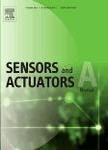版权所有:内蒙古大学图书馆 技术提供:维普资讯• 智图
内蒙古自治区呼和浩特市赛罕区大学西街235号 邮编: 010021

作者机构:Northwestern Polytech Univ Key Lab Micro Nano Syst Aerosp Minist Educ Xian 710072 Peoples R China Northwestern Polytech Univ Ningbo Inst Ningbo 315103 Zhejiang Peoples R China Northwestern Polytech Univ Shaanxi Prov Key Lab Micro & Nano Electromech Syst Xian 710072 Peoples R China Zhisensor Technol Co Ltd Xian 710065 Shaanxi Peoples R China Hisense Laser Display Co Ltd Qingdao 266000 Shandong Peoples R China
出 版 物:《SENSORS AND ACTUATORS A-PHYSICAL》 (Sens Actuators A Phys)
年 卷 期:2025年第383卷
核心收录:
学科分类:12[管理学] 1201[管理学-管理科学与工程(可授管理学、工学学位)] 0808[工学-电气工程] 08[工学] 0804[工学-仪器科学与技术]
基 金:National Natural Science Founda-tion of China [U21B2035, 62074128] Key-Area Research and Development Program of Guangdong Province [2021B0101410001]
主 题:Resonant MEMS scanning mirrors Peak angle limit Quasi-linear operation Cubic nonlinearity
摘 要:Resonant microelectromechanical system (MEMS) scanning mirrors play a crucial role in the rapid and broad manipulation of laser beams, attributed to their compact dimensions and low power requirements. However, in the context of nonlinear dynamics, a bifurcation phenomenon arises when the vibration angle surpasses a certain limit, leading to a discontinuous angle-frequency relationship. This discontinuity significantly complicates the control of resonant MEMS scanning mirrors, particularly when they operate at peak angle. Therefore, it is imperative to investigate the onset of bifurcation, specifically the peak angle limit for quasi-linear operation of nonlinear resonant MEMS scanning mirrors, below which the angle-frequency relationship remains continuous. In this study, an example of resonant MEMS scanning mirrors with cubic nonlinearity was utilized to explore the peak angle limit. By solving the dynamic equation, a theoretical expression for the peak angle limit was derived. The influences of the relevant parameters on the peak angle limit are determined. To obtain a larger peak angle limit, it is required to increase the damping coefficient (c) and decrease the absolute value of the cubic spring constant (k3). The MEMS mirror with a set of specific parameters was fabricated and tested to validate the theoretical findings. The results from both theoretical and experimental investigations demonstrated a high degree of concordance, with a peak optical angle limit difference of 0.9 degrees. These findings provide theoretical foundation for enhancing the peak angle limit for quasi-linear operation and improving stability of MEMS mirrors.